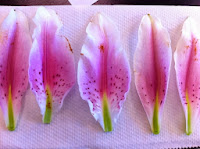Woohoo!
Today in class we did our first dissection ever! It wasn't as cool as dissecting an animal but at least it wasn't as messy either!
Labelling:
This particular flower had 6 Anthers. The anthers are the brown parts on top and they contain the pollen which means that they are the Male part of the flower. The stem which holds the anthers is called the Filament. Together this part of the plant is called the Stamen.
In this photo, the small dark sport on the left of the stem is called the Stigma and is the Female part of the stem. The stem which holds the Stigma is called the Style. And the thick part on the bottom is the ovary which contains the ovule/egg. Together, this part of the plants is called the Pistil.
This flower had 6 colourful Petals which means it is a Monocot plant. (Monocot plants have petals in groups of 3).
Here is a close-up of the Pollen found on the Anther. Truthfully, I think that the pollen looks like a bunch of insect eggs which does not appeal to me. I don't like insects and I definitely don't like theri eggs.
Now here is a close-up of an Ovule/Egg! As you can see it is unfertilized but it is still an interesting thing to be seen.
Pollination:
Pollination is the transfer of pollen (from the anthers) to the stigma. From there, the pollen can reach the egg and that is when Fertilization occurs. Pollen is transfered from the anther to the stigma through wind or through pollinators such as birds, bees, or other insects. The stigma is quite sticky which make pollen easier to attract. Now that you know what Pollination is, there are two tuypes of pollinaton; Self-Pollination and Cross-Pollination. Self-Pollination is when the pollen from one plant pollinates the stigma from the same plant. Some benefits of Self-Pollination is that it allows the plant to keep the traits that are to theri advantage. On the other hand, Cross-Pollination is when the Pollen from one plant pollinates a stigma found on a different plant! This also gives plants a great advantage because it allows more diversity within the plants which allow them to develop new traits. And new traits might lead to a higher chance of survival.
Classification:
In Conclusion, I think the flower we dissected today would be a Monocot because it has all the traits of a monocot. For example its veins on the leaves are parallel to one another and the plant has 6 petals. And Monocot Plants always have petals in multiples of 3.








Great, complete post Kenzie. I like that your pictures and descriptions are easy to follow. Great info as well in your paragraphs. Right on.
ReplyDelete